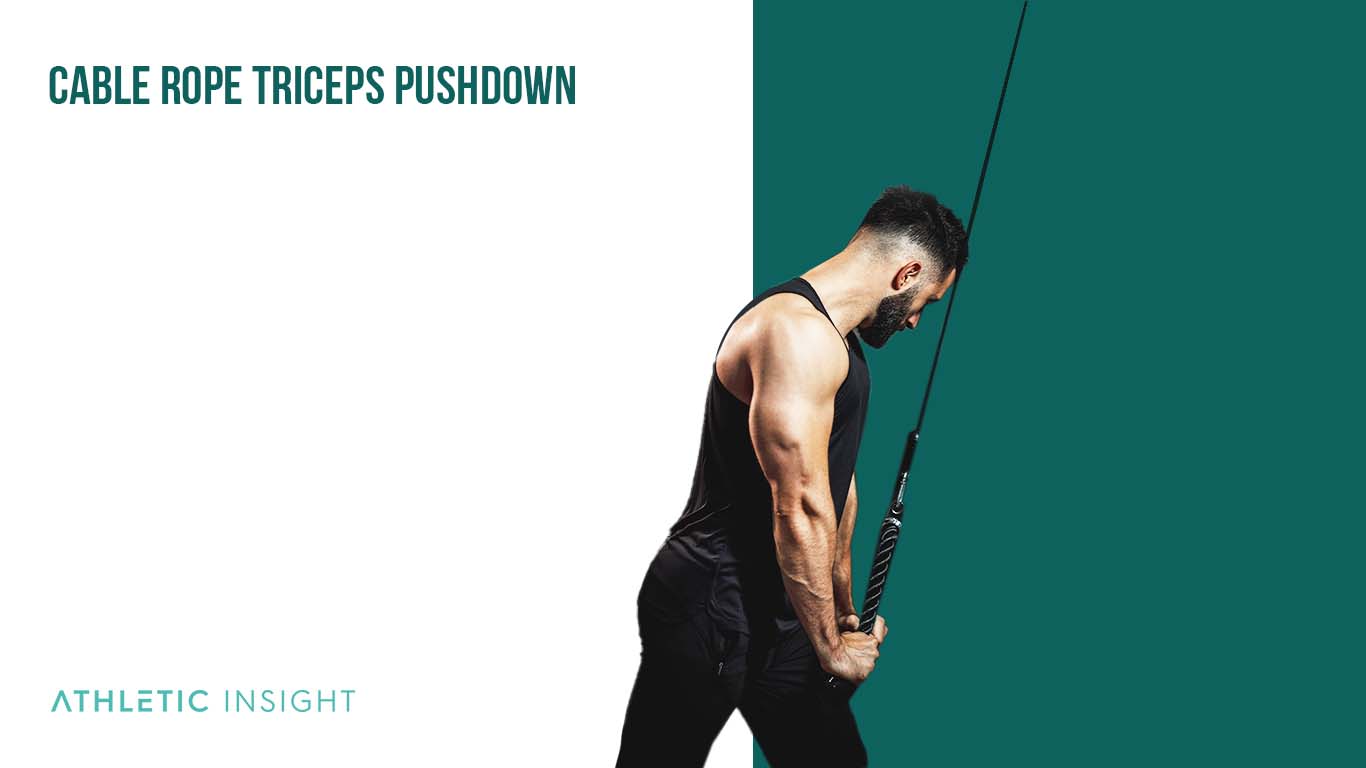A classic tricep pushdown, sometimes called a triceps cable press, is a simple movement used by athletes and weightlifters that targets the triceps brachii. It’s traditionally performed using a cable machine. The weightlifter faces the cable machine with their elbows bent at the waist and hands at chest level. The individual then pushes the bar toward the floor to perform the classic tricep pushdown.
The classic tricep pushdown primarily works the triceps, but variations in equipment, grip, and posture work different muscles. Using various equipment, as with the kettlebell Tricep Pushdown variation and trap bar Tricep Pushdown variation, makes the Tricep Pushdown exercise accessible to people who don’t have easy access to a cable machine.
All Tricep Pushdown variations can activate more muscles than just your triceps, such as lats and upper chest, while isolating strength in your triceps. Using a carefully chosen Tricep Pushdown variation allows lifters to customize their workout routine for their desired results.
Some tricep cable variations make the tricep pushdown more effective for certain types of athletes, such as powerlifters and bodybuilders, due to how the exercise is performed. Tricep Pushdown weight variations make the tricep variation more or less challenging for novices and experienced lifters.
This list covers the six most common tricep pushdown variations.
- Cable Rope Triceps Pushdown
- V Bar Triceps Pushdown
- Reverse Grip Cable Triceps Pushdown
- Cable Back Incline Pushdown
- Band Triceps Pushdown
- Triceps Pushdown With Straight Bar
1. Cable Rope Triceps Pushdown
The Cable Rope Triceps Pushdown variation is a classic Triceps Pushdown variation that works the triceps brachii muscles for athletes and bodybuilders. It uses a tricep cable pushdown machine with a rope handle rather than a bar. Using a rope allows the lifter to use a neutral grip when performing the Triceps Pushdown exercise to target the triceps equally.

The Cable Rope Pushdown triceps variation should be chosen by athletes who want to work their triceps evenly. It should also be selected by bodybuilders and powerlifters who wish to target specific parts of the tricep brachii by adjusting how they hold the rope handles. Using a tricep pushdown rope vs. v bar allows the lifter to make minute targeting adjustments.
When performing the Cable V-Rope Triceps Pushdown, the most common mistake is unevenly pushing the rope handles, which results in an imbalanced lift. For best results, lifters should keep their elbows locked into place while performing the Cable Rope Triceps Pushdown variation. Maintain good posture by leaning forward slightly, but don’t push with the back.
The Cable Rope Triceps Pushdown variation can be performed by beginners and advanced lifters alike by adjusting the weight used on the tricep rope pushdown machine.
2. V Bar Triceps Pushdown
The V-bar Triceps pushdown is a classic Tricep Pushdown variation that works the triceps with a focus on the lateral head of the triceps brachii for powerlifters and bodybuilders. The V-Bar Triceps Pushdown uses a V-shaped bar attached to the cable machine to give the lifter an angled grip while working their triceps on cables.
The V-Bar Triceps Pushdown or V-Grip Pressdown forces the lifter to use a grip that’s halfway between neutral and overhand. This grip angle impacts the muscles worked, targeting the lateral triceps more than a classic neutral grip. Lifters should choose the V-Bar vs. Rope Pushdowns whenever they want a more stable hold, either to slow down and isolate the muscle movements or to lift more weight.
The most common mistake lifters make while performing the V-Bar Triceps Pushdown is letting the cable machine retract itself without maintaining control, which reduces the workout’s effectiveness and can lead to injury, especially at higher weights. To perform the V-Bar Triceps Pushdown safely, retain control throughout the exercise, and avoid arching your lower back.
The V-Bar Triceps Pushdown is a beginner-friendly exercise because novice lifters can do it correctly at a low weight. However, increasing weight is also suitable for experienced powerlifters and bodybuilders.
3. Reverse Grip Cable Triceps Pushdown
The Reverse-Grip Cable Triceps Pushdown is a classic Tricep Cable Pressdown variation that focuses on the medial head of the triceps for bodybuilders, strongmen, strong women, and powerlifters. It’s similar to the classic Triceps Pushdown performed with a tricep cable machine and a straight bar, but it uses a reverse grip with the palms down to adjust the muscles worked.
Because of the palms-down grip, the Reverse-Grip Cable Triceps Pushdown, also called the Cable Tricep Pulldown, works the medial head of the triceps brachii more directly than a neutral or overhand grip. It should be chosen by lifters looking for a solid burnout movement to do sets with lots of reps.
The most common mistake lifters make while performing the Reverse Grip Cable Triceps Pushdown is using momentum to complete the lift. For the most effective exercise, lifters should keep their arms at their sides and their backs straight. The Reverse Grip Triceps Pushdown can also be performed with one arm to isolate the triceps more effectively.
Beginners can perform the Reverse Grip Triceps Pushdown at a low weight, but because the grip is a limiting factor in the movement, it’s best performed by more experienced lifters.
4. Cable Back Incline Pushdown
The Cable Back Incline Pushdown is a cable pull Triceps Pushdown variation that focuses on the triceps brachii and, depending on arm position, the trapezius muscles for athletes. Unlike the standard Tricep Pushdown, which is performed standing, the Cable Back Incline Pushdown is performed with the lifter lying on an incline bench at approximately a 45-degree angle.
The incline bench prevents the lifter from using their body weight to complete the Tricep Pushdown. This effectively isolates the tricep brachii and, if performed with straight arms, can also incorporate the trapezius muscles for a multi-muscle workout. The Cable Back Incline Pushdown should be chosen whenever an athlete wants to “cheat-proof” their Tricep Pushdown.
Using an incline bench minimizes a lifter’s mistakes while performing the Cable Back Incline Pushdown, but proper form is still critical. The most common mistake is letting the weights do the work instead of controlling the release, leading to injury, especially at higher weights.
To make the bent-arm Cable Back Incline Pushdown more difficult, lifters can pause when their elbows reach a 90-degree angle, eliminating momentum before continuing to full extension. Incorporate more back muscles by performing the Cable Back Incline Pushdown with arms straight, bringing the bar to full extension in an arcing motion.
Because the incline bench minimizes body movement, the Cable Back Incline Pushdown is a suitable workout for beginners who want to perfect their Tricep Pushdown form. It’s also a valuable workout for more advanced lifters who want to tighten their movements and isolate the tricep brachii.
5. Band Triceps Pushdown
The Band Triceps Pushdown is a beginner-friendly Tricep Pushdown variation that focuses on the tricep brachii muscles for athletes, bodybuilders, and powerlifters who are recovering from injuries. It uses resistance bands attached to a fixed point in place of a cable machine to perform the classic Triceps Pushdown and several other variations.
The Band Triceps Pushdown can be performed using a close or wide overhand, underhand, or neutral grip, which allows it to work the tricep brachii in several different ways. Lifters can adjust the muscles worked by imitating the grip of other classic Triceps Pushdown exercises, such as the V-grip, reverse grip or overhand grip.
The Band Triceps Pushdown should be chosen over a classic Triceps Pushdown whenever a standard rope pushdown machine is unavailable. It can be performed at home or while traveling and is also suitable for athletes recovering from injuries.
The most common mistake lifters make while performing a Band Triceps Pushdown is applying uneven force through the hands, which reduces the workout’s effectiveness and can cause injury. For best results, press evenly through both hands. Lifters can also adjust their grip and posture to isolate specific muscle groups.
The Band Triceps Pushdown is a beginner-friendly exercise that lifters can perform effectively while learning how to tricep pushdown. Advanced lifters can increase the difficulty level by using bands with more resistance or performing the Band Triceps Pushdown one-handed.
6. Triceps Pushdown With Straight Bar
The Triceps Pushdown with Straight Bar is the most common classic Tricep Pushdown variation that focuses on all three heads of the tricep brachii for athletes, powerlifters, and bodybuilders. It uses a cable machine and a straight bar.

The classic version of the Triceps Pushdown with Straight Bar is an overhand grip that evenly works the tricep brachii. Lifters can adjust the muscles worked by moving the grip closer or broader or switching to an underhand grip to work the medial tricep brachii.
The Triceps Pushdown with Straight Bar should be chosen whenever an athlete or lifter wants a steady, even exertion across the triceps. It should also be selected by lifters who want to target one part of the triceps over another, as it’s easily customizable by adjusting the grip.
The most common mistake lifters make while performing the Triceps Pushdown with Straight Bar, as with most variations of the Tricep Pushdown, is leaving their elbows floppy, which reduces the effectiveness of the exercise.
Don’t lock the elbows at full extension to perform the Triceps Pushdown with Straight Bar safely and effectively. Also, limit the range of motion so the forearms don’t come any higher than parallel to the floor for best results.
The Triceps Pushdown with Straight Bar is suitable for beginners, though a neutral grip variation such as the V-Bar Triceps Pushdown would be better as it minimizes the room for error. The Triceps PUshdown with Straight Bar is also suitable for advanced lifters as the grip can be customized and weight-adjusted to meet a lifter’s unique performance goals.
What to Know About Triceps Pushdown Variations?
Facts about Tricep Pushdown alternatives are listed below.

- Muscle Growth: Tricep Pushdown Alternatives can benefit certain muscle groups better than the classic Tricep Pushdown. For example, the Cable Back Incline Pushdown allows a lifter to incorporate the trapezius muscles. At the same time, you can adjust the Straight Bar variation to target the medial, lateral, and long heads of the tricep brachii.
- Difficulty Adjustment: The classic Tricep Pushdown can be challenging for novice lifters who don’t yet have complete control over their movements. Choosing the suitable Triceps Pushdown variation can help beginners get comfortable with the action. Experienced lifters can also choose triceps Pushdown variations to challenge themselves. For example, the V-Bar Triceps Pushdown gives a more stable grip that lets bodybuilders and powerlifters push the weight max.
- Home and Travel Use: For lifters who don’t have access to tricep pushdown equipment in their home gym or on the road, variations like the Band Triceps Pushdown make it possible to perform the Triceps Pushdown anywhere. Athletes don’t have to skip workouts, even while traveling or when they’re too busy to get to the gym.
The Tricep Pushdown and its alternatives both provide tricep muscle growth. Depending on the alternative, you can target different areas of the tricep brachii.
What Are the Common Mistakes in Doing the Tricep Pushdown Variations?
The most common mistake lifters make while performing the Tricep Pushdown, and its many variations are letting their elbows move freely during the movement. Floppy elbows reduce the effectiveness of the exercise and increase the risk of injury, so lifters should be sure to control their movement throughout the entire range of motion.
There are several other common mistakes when performing Tricep Pushdown variations.
- Letting your weight drop
- Arching your back
- Using your upper body to add momentum
Which Type of Tricep Pushdown Variation Is Beginner-Friendly?
One of the best exercises for beginners looking for variations of the Tricep Pushdown is the Band Triceps Pushdown performed with resistance bands, which come in a range of resistances. This allows novice lifters to adjust the difficulty level. Because there are no weights or specialized equipment, the risk of injury is low, and beginners can practice their form risk-free.
There are several beginner-friendly variations on the Tricep Pushdown.
- Cable Back Incline Pushdown
- V-Bar Triceps Pushdown
- Cable Rope Triceps Pushdown
Which Type of Tricep Pushdown Variation Is Good for Weightlifters?
The best Tricep Pushdown variation for weightlifters is the Reverse Grip Cable Triceps Pushdown, which allows lifters to max out their reps for maximum gains. Several other Tricep Pushdown variations are good for weightlifters.
- Cable Back Incline Pushdown
- Triceps Pushdown With Straight Bar
- Cable Rope Triceps Pushdown
Which Type of Tricep Pushdown Variation Is Good for Athletes?
The Triceps Pushdown with Straight Bar is a good Tricep Pushdown variation for athletes because it allows them to adjust their grip and weight to target the desired muscle groups to achieve their fitness goals. Several Tricep Pushdown variations are also suitable for athletes.
- Band Triceps Pushdown
- V Bar Triceps Pushdown
- Cable Back Incline Pushdown
Which Type of Tricep Pushdown Variation Is Good for Bodybuilders?
The Cable Back Incline Pushdown variation is the best Tricep Pushdown variation for bodybuilders because eliminating lower body movement allows bodybuilders to target precisely the muscles they’re trying to bulk up. Several other Tricep Pushdown variations are good bodybuilding exercises.
- Triceps Pushdown With Straight Bar
- V-Bar Triceps Pushdown
- Reverse Grip Cable Triceps Pushdown
Which Tricep Pushdown Variation Is Safer for Elbows?
The Band Tricep Pushdown is a Tricep Pushdown variation that is one of the best exercises for elbows because it relies only on body weight and physical resistance. The lifter can adjust the resistance and range of motion to accommodate any elbow discomfort, bailing on the movement if it ever feels like too much.
The Band Tricep Pushdown should be chosen when an athlete is recovering from an injury. It’s also a good choice for novice lifters who need to practice their form before risking their elbows on a power move.
The most common mistake lifters make when performing a Band Tricep Pushdown is letting their elbows flop, which puts them at risk. To protect their elbows, lifters should keep them tucked close to the waist. Increase the difficulty of the Band Tricep Pushdown by choosing a higher attachment point or using a band with a higher resistance level.
The Band Tricep Pushdown variation is suitable for beginners and advanced lifters alike, especially for those recovering from injuries.
What Are the Alternatives for Tricep Pushdown Exercises?
There are several Tricep Pushdown alternatives.
- Dips
- Close Grip Bench Press
- Triceps Kickback
- Diamond Push-Up
- Skull Crusher
- Triceps Overhead Extension
- Cable Overhead Extension
These Tricep Pushdown alternatives work the triceps in different ways, using equipment that may be available at home, on the road, or at the gym.



